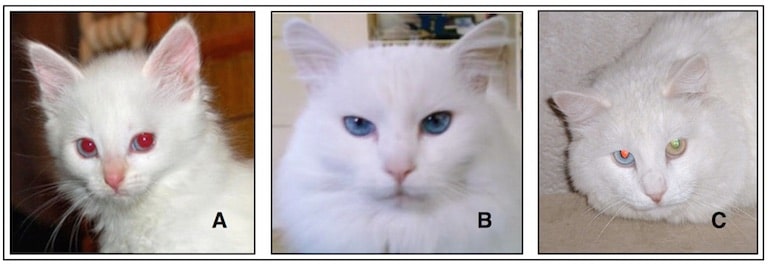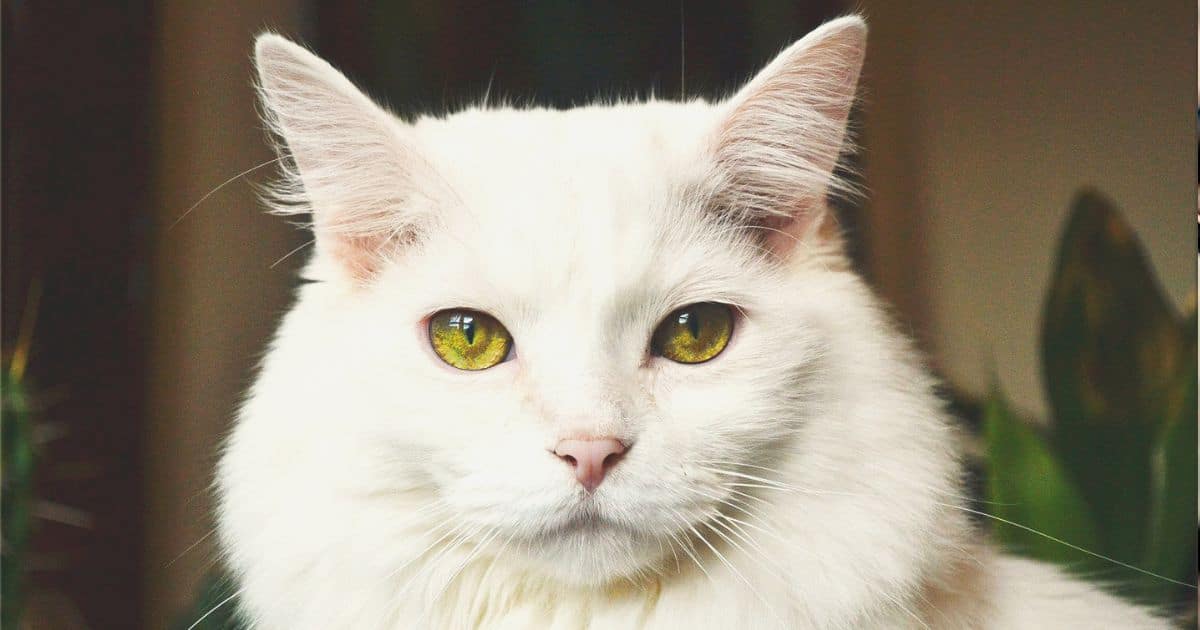White Cats Versus White Cats

The snow-white brilliance of a white cat is a beauty to behold. And, when coupled with different eye colors (green, blue, golden, or “unusual” features), it stands out dramatically from other multi-colored, calico, or tortoiseshell cats. White cats have often been associated with the month of February because their color reminds one of snow.
It is common for people to believe that white cats are albino cats, when in fact the only real similarity between the two is in the apparent white coat color. In an albino cat, the white coat color is attributed to their lack of color. This genetic condition is identified as a complete lack of color or pigmentation, with both parents carrying the genetic marker for albinism.
On the other hand, the white color of a white cat results because the gene for white fur trumps all other potential colors. For the most part, a white cat is a normal cat.
Easiest Way to Distinguish Between an Albino and White Cat
Look at the eyes. An albino cat’s eyes are limited to a very pale blue, or appear pinkish or pinkish-blue due to the complete lack of pigmentation (Figure 1A). White cats have varying eye colors (blue – 1B, green, amber), including the intriguing heterochromia, in which the eyes have two different colors (Figure 1C). So, cats having blue, green, or amber eyes are not albino. Cats B and C are true white cats.

Figure 1. A – albino kitten. The pinkish-red eyes are a reflection of excess light, revealing the color of blood vessels. B – white cat with blue eyes. C – white cat with “odd” colored eyes.
But, as Paul Harvey was known to say, “…and now, the rest of the story.”
The True Beauty May Have Blemishes – Deafness
Deaf White Cats – This describes domestic cats that have completely white (long or short) fur, typically having blue eyes (but could have blue, green, amber, or a combination of color eyes), and having no functional hearing (Figure 2).

Figure 2. A congenitally deaf white cat having blue eyes (A). (C), (D), and (E) are examples of iris colors from white cats that experience deafness and include: (C) two blues eyes; (D) both amber eyes; and (E) a heterochromy (one blue and one amber eye). Photo credits: B. Tiemann (Universitätsklinikum Hamburg-Eppendorf) and A. Burghard (Hannover Medical University).
As early as 1868, Charles Darwin noted that cats, if they have blue eyes, are almost always deaf. The deafness can be in both ears, or less frequently in one ear. The opposite ear would retain residual hearing.
White Coat Color, Blue Eyes, and Deafness
It is estimated that 5% of the overall cat population are white, and that a subpopulation of these are blue-eyed. But, are all white cats with blue eyes deaf? To this, Hartwell (2015) comments:
There is an established link between the white coat color, blue eyes and deafness. The tapetum lucidum is generated from the same stem cells as melanocytes (pigment cells). The blue eyes in a piebald or epistatic white cat indicates a lack of tapetum. Deafness is caused by an absence of a cell layer in the inner ear that originates from the same stem cells as well. In odd-eyed white cats, the ear on the blue-eyed side may be deaf, but the one on the orange-eyed side usually has normal hearing. Not all blue-eyed whites will be deaf since there are several different genes causing the same physical attributes (whiteness, blue-eyedness) so it all depends on the cat’s genotype (its genetic make-up) not its phenotype (its physical appearance). Some people claim that 99% of blue-eyed white cats are deaf. This is inaccurate because blue-eyedness and whiteness can both be caused by different genes. It all depends on what genes the cat has inherited. These are the actual figures from scientific studies around the world. The percentages are given in ranges because results are different in different areas, partly because of the different genes found in the cat population. Where a cat is classed as deaf, the deafness may affect one or both ears.
- 95% of the general cat population are non-white cats (i.e. not pure white) and congenital deafness is extremely rare in non-white cats.
- 5% of the general cat population is white cats (i.e. pure white).
- 15-40% of these pure white cats have one or two blue-eyes.
- Of those white cats with one or two blue eyes, 60-80% are deaf; 20-40% have normal hearing; 30-40% had one blue eye and were deaf while 60-70% had one blue eye and normal hearing.
- Of the 5% of white cats in the overall population, 60-80% had eyes of other colors (e.g. orange, green). Of those 10- 20% were deaf and 80-90% had normal hearing.
- Deaf white cats with one or two blue eyes account for 0.25 – 1.5 of total cat population
- Total number of cats with white coat and blue eyes account for 0.75 – 2.0% of total cat population.
It is evident that blue-eyed white cats exhibit a higher deafness incidence than do other cats, but not all are deaf. The reason is because the coat and eye color can be caused by different genes.
But, Aren’t All Cats Born Deaf?
The answer is Yes. Cats are called altricial animals, and as such, their sensory systems (ears and eyes) become functional after birth. Hearing occurs during the second week of life. Somatosensory and olfactory systems, in contrast, are functional at birth.
So, Why the Interest in Deaf White Cats????
In general, the feline auditory system is similar to humans and cats can perform similar acoustic functions. Their brain contains many cortical auditory areas and they have low-frequency hearing similar to that of humans. Animals with these traits, and being congenitally deafened, are a natural model for human congenital deafness, meaning that they serve as an effective medium to study hearing loss and its effects on the development and function of the auditory system. They serve as an excellent model for investigating multimodal interactions because cats use highly visual and auditory modalities for orientation, similar to humans. Additionally, the feline cochlea is sufficiently large to implant a neuroprosthetic device (cochlear implant) used in humans for hearing restoration and plasticity.
For example, deaf white cats, even in excess of 2 years of age, retain a sufficient number of functionally intact auditory afferents, which are suitable for electrical cochlear stimulation. This information, along with that from a number of subsequent studies, has shown that studying the deaf white cat model, and implanting the cats, has allowed for beneficial demonstrations of hearing restoration using cochlear implants. Experiments helped support evidence-based recommendations on the treatment of congenital deafness in children.
“Today, approximately 400,000 hearing impaired individuals world-wide benefit from cochlear implants in their daily life. Given the present rate of implantation, the number of people using cochlear implants is projected to reach one million in 2020. Overall, the cochlear implant is the most successful neuroprosthetic device “(Kral and Lomber, 2015). And, the deaf white cat has been instrumental in its success.
References
- Pena, M. The Difference Between an Albino Cat and a White Cat, Caster, Aug. 28th 2014, .
- Darwin, Charles. 1868. The Variation of Animals and Plants Under Domestication
- Kral, A. and Lomber, S.G. Deaf white cats, Current Biology, Vol. 25, R345-R361, May 4, 2015
- Hartwell, S. White cats, eye colours and deafness,
- Held, S., Hartmann, R., Klinke, R. A model for prelingual deafness, the congenitally deaf white cat — population statistics and degenerative changes, Hearing Research, 1998, Jan:115(ss1-2):101-12
In Full Disclosure: As a “dog” person, writing about “cats”, I constantly experienced the chills related to chalk screeching on a blackboard.







